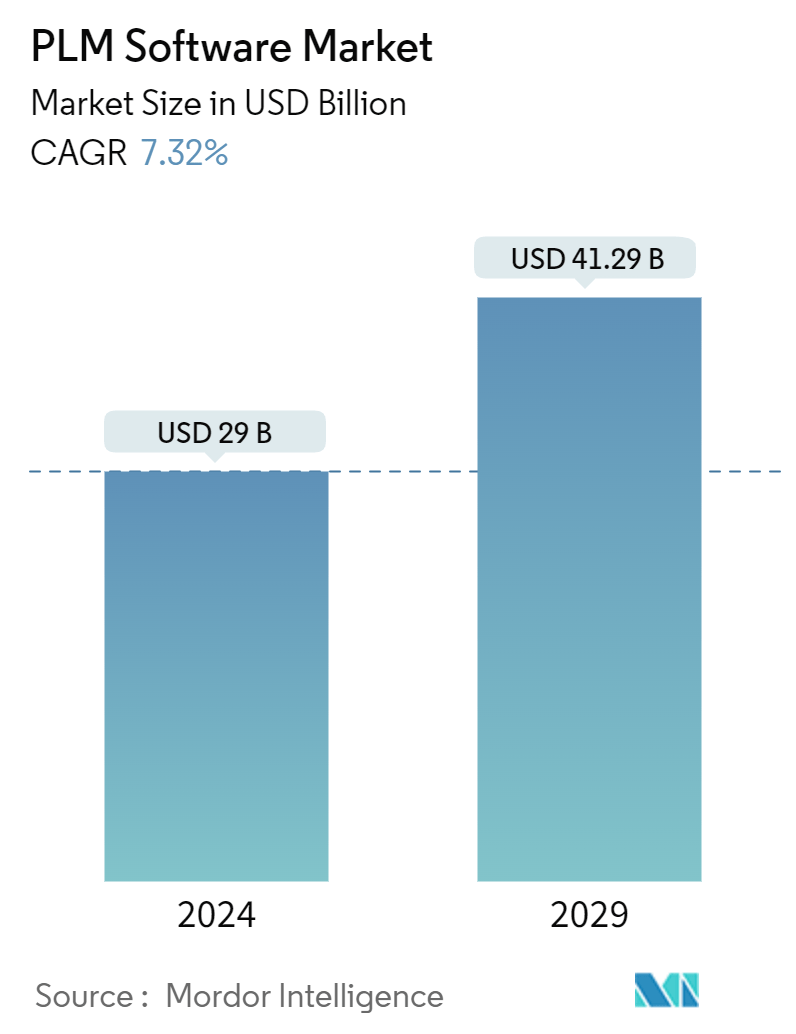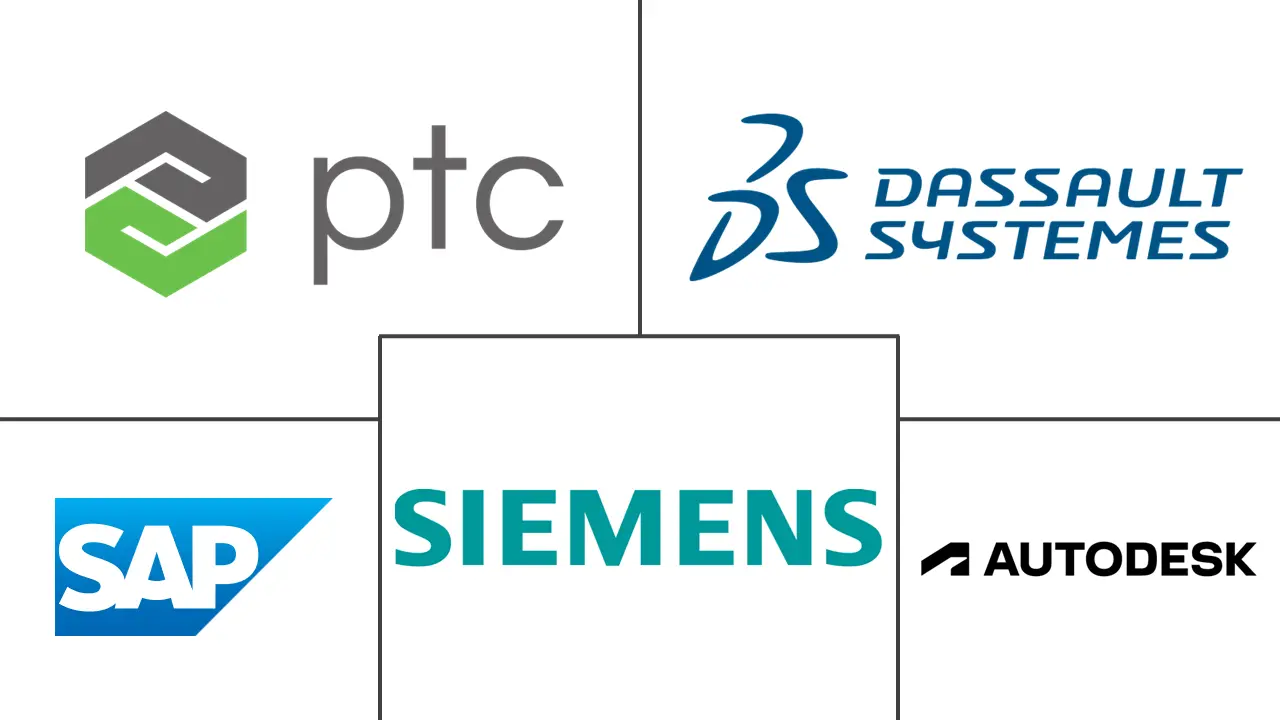Market Size of PLM Software Industry

| Study Period | 2019 - 2029 |
| Market Size (2024) | USD 29 Billion |
| Market Size (2029) | USD 41.29 Billion |
| CAGR (2024 - 2029) | 7.32 % |
| Fastest Growing Market | Asia Pacific |
| Largest Market | North America |
| Market Concentration | Low |
Major Players
*Disclaimer: Major Players sorted in no particular order |
PLM Software Market Analysis
The PLM Software Market size is estimated at USD 29 billion in 2024, and is expected to reach USD 41.29 billion by 2029, growing at a CAGR of 7.32% during the forecast period (2024-2029).
The PLM software market size is estimated to account for USD 29 billion in 2024. It is expected to reach USD 41.29 billion by 2029, registering a CAGR of 7.32% during the forecast period (2024-2029), owing to the growing demand for robust data analytics software platforms in the industry. Moreover, the increasing adoption of IoT across the manufacturing industry has augmented these trends. PTC's Windchill is an instance of the PLM software embedded with analytics for discrete manufacturers looking for IoT capabilities. This software can boost the PLM solution to sprint with flexibility.
- Companies across industries are increasingly focused on streamlining their product development processes to improve efficiency and accelerate innovation. PLM software enables organizations to manage the entire product lifestyle, from ideation to disposal and efficiency, thereby increasing the demand in the market.
- With businesses operating on a global scale and teams dispersed across various locations, there is a growing need for collaboration tools that facilitate communication and data sharing. PLM software provides a centralized platform for teams to collaborate seamlessly regardless of geographic location.
- The increased adoption of Industrial IoT (IIoT) in the production process is aiding the market demand for software applications, and IIoT adoption is expected to skyrocket during the forecast period. For instance, according to GSMA Intelligence, the number of IIoT-connected objects is expected to reach 13.7 billion by 2025.
- However, as the companies continue to provide different products and product ranges to tackle market competitiveness, it creates interoperability issues, a matter of constant optimization for the software companies. As continuous improvements continue in the software products, the software implementation in a company's existing product line-up becomes streamlined and manageable, facilitating better results.
- Many manufacturing industries were affected by the COVID-19 pandemic, creating significant supply chain gaps and leading to delays. This forced many industries to hasten the adoption of Industry 4.0 and digital transformation initiatives, boosting the demand for PLM software to bolster the required growth rates. The increased software penetration after the pandemic has boosted market growth.
PLM Software Industry Segmentation
PLM software refers to a solution that helps manage all the information and processes involved in the lifecycle of a product or service across global supply chains. This includes data related to items, parts, products, documents, requirements, engineering change orders, and quality workflows. The product lifecycle management (PLM) software market for the study defines revenues generated from adopting the different types of PLM software in various end-user industries, such as electronics, industrial equipment, automotive, aerospace, and defense. The analysis is mainly based on the market insights captured through various secondary research and the primaries. The market also covers the major factors impacting the growth of the PLM software market in terms of drivers and restraints.
The product lifecycle management (PLM) software market is segmented by deployment type (on-premise, cloud, and professional services), end-user industry (electronics, industrial equipment, high-tech, aerospace and defense, automotive, architecture, engineering, and construction [AEC]), and geography (North America, Europe, Asia-Pacific, Latin America, and Middle East and Africa). The market sizes and forecasts are provided in terms of value (USD) for all the above segments.
| By Deployment Type | |
| On-premise | |
| Cloud | |
| Professional Services |
| By End-user Industry | |
| Electronics, Industrial Equipment, and High-tech | |
| Aerospace and Defense | |
| Automotive | |
| Architecture, Engineering, and Construction (AEC) | |
| Other End-user Industries |
| By Geography | ||||||
| ||||||
| ||||||
| ||||||
| Latin America | ||||||
| Middle East and Africa |
PLM Software Market Size Summary
The product lifecycle management (PLM) software market is poised for significant growth, driven by the increasing demand for advanced data analytics and the adoption of IoT technologies across manufacturing sectors. PLM software plays a crucial role in streamlining product development processes, enhancing efficiency, and fostering innovation by managing the entire product lifecycle from ideation to disposal. The need for collaboration tools that facilitate seamless communication and data sharing among globally dispersed teams is also propelling market demand. The integration of Industrial IoT in production processes is expected to further boost the adoption of PLM software, as industries seek to optimize operations and improve connectivity. The COVID-19 pandemic has accelerated the digital transformation initiatives, prompting industries to adopt PLM software to address supply chain disruptions and enhance growth trajectories.
In the automotive sector, the rising complexity of autonomous vehicle development is driving the demand for sophisticated PLM solutions that can integrate various data feeds and streamline development processes. North America's strong financial position and the presence of major PLM software vendors contribute to intense competition and robust market growth in the region. The automotive industry's expansion in North America presents lucrative opportunities for PLM software, particularly in the product development stage. Collaborations and strategic partnerships among key players, such as Siemens, Microsoft, and PTC, are enhancing market dynamics by integrating advanced technologies and fostering cross-functional collaboration. The market remains highly competitive, with numerous global players investing in R&D, forming partnerships, and introducing innovative products to capture market share.
PLM Software Market Size - Table of Contents
-
1. MARKET INSIGHTS
-
1.1 Market Overview
-
1.2 Industry Attractiveness - Porter's Five Forces Analysis
-
1.2.1 Bargaining Power of Suppliers
-
1.2.2 Bargaining Power of Consumers
-
1.2.3 Threat of New Entrants
-
1.2.4 Threat of Substitutes
-
1.2.5 Intensity of Competitive Rivalry
-
-
1.3 Impact of COVID-19 on the Product Lifecycle Management Software Market
-
-
2. MARKET SEGMENTATION
-
2.1 By Deployment Type
-
2.1.1 On-premise
-
2.1.2 Cloud
-
2.1.3 Professional Services
-
-
2.2 By End-user Industry
-
2.2.1 Electronics, Industrial Equipment, and High-tech
-
2.2.2 Aerospace and Defense
-
2.2.3 Automotive
-
2.2.4 Architecture, Engineering, and Construction (AEC)
-
2.2.5 Other End-user Industries
-
-
2.3 By Geography
-
2.3.1 North America
-
2.3.1.1 United States
-
2.3.1.2 Canada
-
-
2.3.2 Europe
-
2.3.2.1 United Kingdom
-
2.3.2.2 Germany
-
2.3.2.3 France
-
2.3.2.4 Rest of Europe
-
-
2.3.3 Asia Pacific
-
2.3.3.1 India
-
2.3.3.2 China
-
2.3.3.3 Japan
-
2.3.3.4 Rest of Asia-Pacific
-
-
2.3.4 Latin America
-
2.3.5 Middle East and Africa
-
-
PLM Software Market Size FAQs
How big is the PLM Software Market?
The PLM Software Market size is expected to reach USD 29 billion in 2024 and grow at a CAGR of 7.32% to reach USD 41.29 billion by 2029.
What is the current PLM Software Market size?
In 2024, the PLM Software Market size is expected to reach USD 29 billion.

